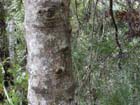Halocarpus kirkii
(F. Muell. ex Parl.) C.J. Quinn 1982
Common names
Monoao. This is also the name of another native New Zealand podocarp, and of a New Zealand flowering shrub.
Taxonomic notes
Syn: Dacrydium kirkii F. Mueller 1868 (Quinn 1982). Type locality: Great Barrier Island. Type: K, T. Kirk." (Allan 1961).
Description
Dioecious trees up to 25 m tall and 100 cm dbh. Lower branches spreading, upper ones erect. Young trees taper upwards and are graceful in habit. Final branchlets 1-2 mm in diameter, subterete. Bark grey-brown, smooth on young trees but on old trees thick, flaky, and pustular. Foliage displays juvenile and mature forms, the juvenile foliage often persisting on lower branches until the tree is about 10 m tall. Juvenile leaves and reversion shoots narrow and leathery, up to 1.5-4 cm × 1-3 mm, obtuse to acute to mucronate; petiole short, twisted. Mature leaves small, scale-like, closely pressed, 2-3 mm long, obtuse, coriaceous, with membranous margins, faint keels, and many irregularly arranged stomata. Pollen cones solitary, terminal, sessile, up to 1 cm long. Female strobili form a short oblong head, 6-12 mm long. Seeds ovoid-oblong, somewhat compressed, striate, 3-8 mm long, with epimatium completely covering seed. There is also an orange aril. Wood is pale brown-red, tight-grained (Allan 1961, Dallimore et al. 1967, Salmon 1996).
Distribution and Ecology
New Zealand: found occasionally in lowland forests to an altitude of 700 m from Puketi Forest in the north (pers. obs., 17-Mar-2003) to the southern end of the Coromandel Peninsula, and on Great Barrier Island (Salmon 1996). Within its range, mean annual temperature is 13.8°C, with an average minimum in the coldest month of 6.7°C, and a mean annual precipitation of 1479 mm (Biffin et al. 2011, Table S5).
Where I have seen it, it has grown in association with kauri (Agathis australis) in closed-canopy forest on fairly well-drained ridgetop sites. This setting also describes the trees photographed by Salmon (1996).
Zone 9 (cold hardiness limit between -6.6°C and -1.1°C) (Bannister and Neuner 2001).
The IUCN reports that this taxon is "Near Threatened", facing a high risk of extinction in the wild due to recent and forecast reductions in population size.
Remarkable Specimens
No data as of 2023.02.21.
Ethnobotany
Salmon (1996) says that the pale reddish-brown wood is strong and very durable, but given the tree's rarity (I have not found evidence that the Maori even had a name for it), it seems unlikely that it ever had much ethnobotanical significance.
Observations
On the North Island, I found it in two places: the Toatoa Grove walk in Waipoua Forest, and the Gorge Loop walk in Puketi Forest, both located well north of Auckland; both sites were in kauri (Agathis australis) forest. On the Toatoa Grove walk the plants are growing with mature kauri and sapling toatoa (Phyllocladus toatoa) at the farthest point of the loop, and on the Gorge Loop the plants are growing in a fine kauri grove with toatoa and montane totara (Podocarpus laetus) about 50-100 m before the end of the loop (if the loop is followed in the recommended anticlockwise direction).
At both sites described there were seedlings and saplings up to 8 m tall, bearing juvenile foliage; despite much searching and inquiries at Department of Conservation offices, I never located a plant bearing adult foliage. The juvenile foliage is quite distinctive, superficially resembling that of juvenile Podocarpus totara and Podocarpus laetus, but soft and flexible whereas the Podocarpus species have stiff foliage with a sharp point. The adult scale-like foliage evidently bears a close resemblance to that of the other New Zealand scale-leaved forest conifers, Halocarpus biformis, Lepidothamnus intermedius, and Manoao colensoi, and I have not found any source describing how these foliages can be distinguished. Fortunately all of these species have characteristic juvenile foliage.
Remarks
The species is named for Thomas Kirk (1828-1898; in New Zealand after 1863), botanist, naturalist, teacher (Salmon 1996), and author of an early comprehensive book about New Zealand trees (very well illustrated, it deserves to be reprinted).
Citations
Allan, H. H. 1961. Flora of New Zealand. Volume I, Indigenous Tracheophyta. Wellington: R.E. Owen Government Printer.
See also
Gymnosperms of New Zealand.
Hooker, J. D. 1877. Ic. Pl., t. 1219.
Kirk, T. 1889. Forest Flora of New Zealand, 191, t. 97.
The New Zealand Plant Conservation Network, accessed 2010.11.22.



